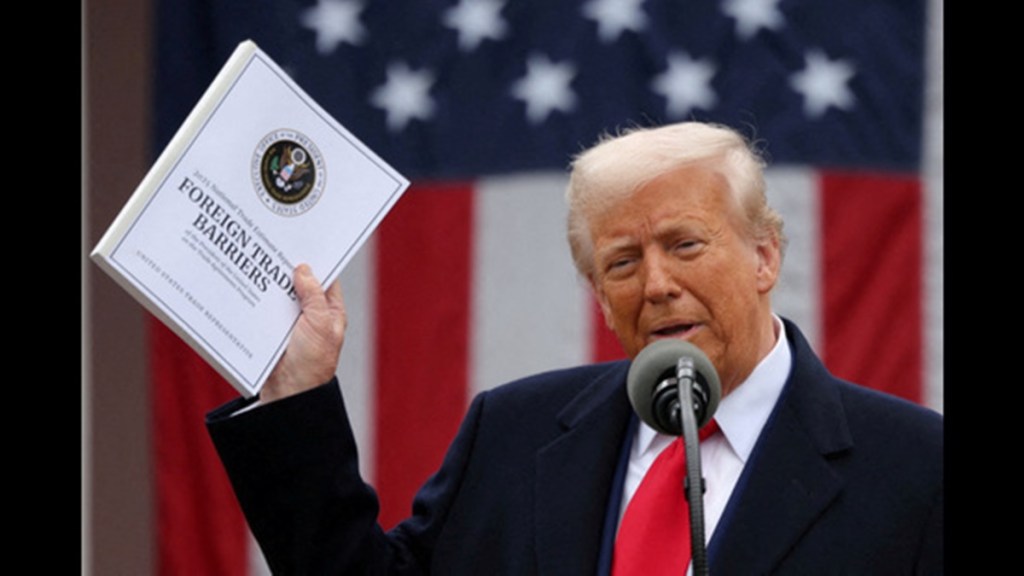By Abhijit Das
After having governments in many countries on edge, markets jittery, and trade analysts speculating for the past few days, President Donald Trump unveiled his reciprocal tariff plan on April 2. This is likely to create considerable turmoil in global markets and adversely impact the exports of many countries. What are the key points emerging from Trump’s executive order on reciprocal tariffs? How is India likely to be impacted? How should India respond to the latest salvo from President Trump?
In accordance with Trump’s executive order, from April 5 the US will start charging a baseline additional ad valorem tariff of 10%, which will apply to all imports of more than 100 countries. Further, from April 9, the US would start charging higher additional duties on about 60 countries. Countries that would face higher additional duties include China (34%), European Union (20%), India (27%), Japan (24%), South Africa (30%), Thailand (36%), and Vietnam (46%).
Some of the smaller and least developed countries are set to face very high additional duties. These include Bangladesh (37%), Cambodia (49%), Laos (48%), and Lesotho (50%). Some countries for which the baseline additional duty will not increase above 10% even after April 8 include the following: Argentina, Australia, Brazil, Colombia, Singapore, Turkey, and United Kingdom.
It is relevant to note that certain products including copper, pharmaceuticals, semiconductors, lumber articles, some critical minerals, and energy and energy products have been exempted from the additional tariffs under the reciprocal tariff plan.
From multiple perspectives, the recently announced reciprocal tariffs will result in a breach of the commitments of the US at the World Trade Organization (WTO). In respect of most of the products, the total customs duties that the US will apply from April 5 onwards will exceed its commitment on bound tariffs.
Further, as different amounts of customs duties would be applied on imports of a product depending on the source country, this would violate the requirement of non-discriminatory treatment, commonly referred to as the most-favoured nation provision.
Three additional points in the executive order are worth noting. First, if any trading partner retaliates against the US, President Trump may further increase or expand the scope of the additional duties imposed under the reciprocal tariffs. This is aimed at discouraging countries from hitting back at the US for its proposed illegal tariffs. Second, with a view to encouraging countries to lower their tariffs and address the concerns of the US on some regulatory issues, there is a possibility to decrease or limit the scope of these additional duties. Third, apprehending domestic backlash on these tariffs, President Trump has called upon the public and private sectors to “make the efforts necessary to strengthen the international economic position of the United States”.
Turning to India, the 27% additional ad valorem duties as the reciprocal tariff would be bittersweet. As India and the US are intensely engaged in negotiations for a multi-sectoral bilateral trade agreement (BTA), it was reasonable to expect that India would be spared the reciprocal tariffs. Indian officials and industry would be disappointed at being hobbled with the additional duties. However, on three counts there could be some optimism.
First, despite being repeatedly pilloried by Trump as “Tariff King”, India has escaped the fate of many countries, such as China and Vietnam, which will be at the receiving end of much higher tariffs. Second, as many pharmaceutical products have been exempted from the scope of reciprocal tariffs, this should provide some relief to Indian exporters. This sector accounts for around $8-9 billion of India’s exports to the US. Third, with some of India’s competitors in the textile and clothing sector facing much higher duties, our domestic industry could smell a business opportunity in this development. Whether they will be able to take advantage of this opening would depend on their ability to quickly scale up their operations. Further, they may also need to absorb some of the price increases on account of the additional tariffs, so as not to pass the entire burden on to the shoulders of the US consumers.
Going forward, how should India respond to the 27% additional duties? First, in private conversations with the US government, Indian officials and political functionaries must express their deep disappointment at India being subjected to the additional duties especially when the two countries are engaged in the BTA negotiations. Second, India could also highlight the various unilateral concessions extended to the US in the past two months and press for removal, or at least substantial reduction, of the additional duties. Third, if the US is not responsive to India’s concerns, the government must not hesitate in exploring options for defending our national interest. Fourth, India must seek to ensure that its objective in BTA negotiations is not confined to seeking removal of the 27% additional duties. It must also endeavour to secure deeper tariff concessions from the US on products of its export interest, including textiles and clothing and leather products. Finally, at the WTO India must do its bit in trying to restore the primacy of the rules-based multilateral trading system. It should be forthcoming in joining hands with countries who might seek to confront the US for breaching its legally binding WTO commitments.
In conclusion, Trump’s reciprocal tariffs could throw global trade into considerable uncertainty. While India’s exports to the US might be adversely impacted, it is not likely to be disruptive for the Indian economy. India must remain cognisant that as the voice of the Global South, how it responds to the recent actions of the US is likely to influence the future trajectory of the WTO.
The author is an international trade expert.
Disclaimer: Views expressed are personal and do not reflect the official position or policy of FinancialExpress.com. Reproducing this content without permission is prohibited.

